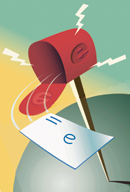

Toward E-mail
Rules of
EngagementBy Howard Guttman

-
Howard Guttman, BA’72 (M), is author of When Goliaths Clash: Managing Executive Conflict to Build a More Dynamic Organization, from which this article is adapted. He is the principal of Guttman Development Strategies, a Ledgewood, N.J.-based management consulting firm specializing in building high-performance teams, executive coaching and strategic and operational alignment. At Fairleigh Dickinson, he majored in history and minored in psychology. He has served as an adjunct faculty member in FDU’s School of Psychology, teaching the graduate course Behavioral Consulting. His e-mail address is
hmguttman@
guttmandev.com.
By following the 10 rules discussed below, many executives have found that both their e-communication skills and their ability to use e-communication as a conflict-management tool have greatly improved. The same rules apply to any electronic exchange and can be tried in correspondence with family, friends, businesspeople and service providers as well as at work.
1. Use the right medium for the message.
E-mail is a very effective tool for one-way communication, but it does not lend itself to situations that require interactive communication. E-mail is perhaps best used when you just want to share information and don’t need a response.In one organization with which we have worked, e-mail is clearly defined as a communication, not a decision-making, vehicle. Team decisions are made interactively: in person, on the phone, during videoconferences. Decisions in progress are not to be discussed in e-mails, period. It is also unacceptable to use e-mail to either raise an issue of concern/conflict or to engage in negotiations. The reason, as one chief financial officer put it: “Nine times out of 10 a conflict is more easily resolved by face time than by playing dueling e-mails for weeks on end.”
2. Read with your brain, not just your eyes.
Resist the temptation to reply to a person’s message with advice, judgmental remarks or disinterest. Instead, decode and feed back the message as you interpret it or ask for further clarification. First, ask yourself, “Is the content of this message clear?” You may have to read between the lines. For example, if the e-mail message relates to a problem, ask yourself: “Is the sender trying to determine the cause? Does the sender want me to supply information to help in the search for the cause? Am I being asked to take or recommend corrective action to remove the cause of the problem?”Next, step back and take a wide-angle view of the message. Ask, “What are the underlying feelings being conveyed or implied? Do I detect frustration, anger, confusion? If so, are these feelings being directed at me or at my area of responsibility?” Now you are better positioned to respond.
3. Practice the Golden Rule.
Put yourself mentally in front of the computer screen of the recipient. Ask yourself, “How would I react to the message coming across the screen? Would the message be clear? Would I know what action, if any, I was being asked to take? What feeling or emotion would the message be likely to engender in me?” In other words, think before you send.4. Respect confidentiality.
Never, ever pass along a confidential e-mail to anyone not authorized to read it. It’s also important to understand that there is no privacy on the Internet. Anything and everything can be discovered with the right tools in the wrong hands. A security breach could result in hackers having access to sensitive materials, and confidential plans can reach the competition through e-mail. All sensitive and confidential information should be delivered face to face.5. Know when — and when not — to “cc.”
Every organization should have protocols in place to address the “cc” issue. When in doubt, reach agreement with those involved before you “cc” and hit “send.” Likewise, “cc” people on your e-mail only when it is absolutely necessary for them to be kept informed.6. Don’t retain a rescuer.
Don’t circulate an e-mail received to a third party and then have that individual join in the response. Deal one on one. The one exception: if you get permission from the e-mail sender to broaden involvement.7. Stroke the recipient.
Telemarketing coaches advise their clients to “make sure your voice has a smile.” Similarly, executives would be better served if, whenever possible, their e-mail stroked the recipient. Look for an opportunity to congratulate or thank someone.And why not use e-mail to “bury the hatchet?” We’ve seen cases in which there has been a strained relationship between two people, and, when the conflict has eased, one of the parties has sent an e-mail to the other thanking or congratulating the former adversary: “Thanks so much for the work you did on the marketing plan; you and your team were tremendously helpful to us” or “Congratulations! I heard you got the XYZ account.”
8. Get to know your e-mail correspondents.
Just being able to match a face with a name makes it easier to infuse your electronic correspondence with a friendly, more personal tone. When routinely corresponding with outside vendors, people on other shifts or employees of other departments or divisions, why not take some time to introduce yourself in person? On a trip to see the corporate H.R. folks, why not stop in and say “hello” to the purchasing agent with whom you have “spoken” only through your computer? Or, if you’re working overtime one night, why not walk into the plant and say “hi” to the night production supervisor?9. When in doubt, don’t.
Suspend responses, especially when angry or upset. Write the message, hit “save,” then send it to your own e-mail address. Wait 24 hours, then open and reread the message. How would it come across if you were the recipient? If it passes the content-and-feelings litmus test, go ahead and send it.10. Pack a parachute.
Finally, don’t be afraid to bail out of e-mail, especially when you sense the undertow of strong emotion. Before the situation deteriorates — before misunderstandings escalate and harsh messages are exchanged — that’s the time to suggest getting together by telephone or in person.
FDU Magazine Home | Table of Contents | FDU Home | Alumni Home | Comments
©Copyright 2004 Fairleigh Dickinson University. All rights reserved.
For a print copy of FDU Magazine, featuring this and other stories, contact Rebecca Maxon, editor,
at 201-692-7024 or maxon@fdu.edu.